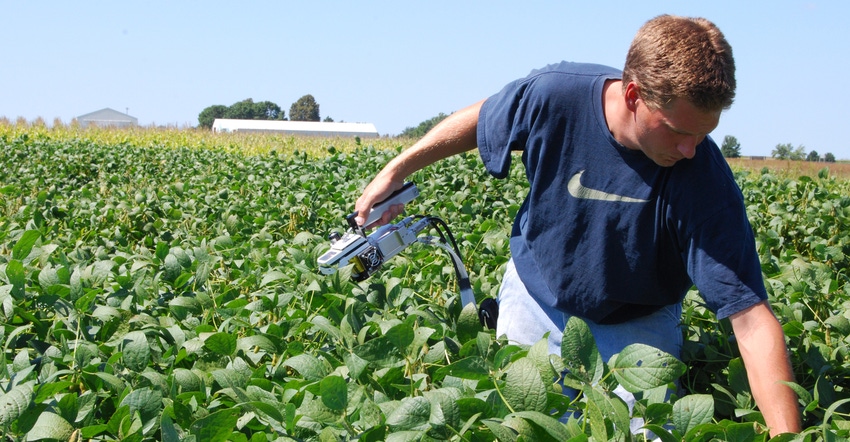June 22, 2020

With 2020 being an election year, the ads will be relentless, so we’ll probably all need a break from TV, radio and social media occasionally. There are likely other more exciting (or more relaxing) things to do or places to be, but scouting soybean fields has a lot to offer! Scouting to find issues early and taking action when needed is still the best method for a lot of our pest issues.
Here are a few things to keep an eye out for in soybean fields as we head through midsummer:
Foliar diseases. Pathogens like septoria brown spot, cercospora and frogeye come to mind since they are more common, but there are others to watch for, so take your favorite scouting app or field guide with you. Often, if these foliar diseases stay in the lower third of the canopy, they don’t impact yield. If they head into the middle third of the canopy, then we start to take notice.
If your scouting finds this happening, work with your local agronomist to positively identify the disease and determine if fungicide application is needed. Now that we have strobilurin fungicide-resistant frogeye isolates in Iowa, it becomes especially important to understand when to spray and what products to use for long-term control of this disease.
Sudden death syndrome. One thing we’ve learned from outbreaks of SDS in recent years is this disease likes wet weather, especially in spring. Although this year we generally didn’t suffer as wet a spring as some recent years, there are areas that had significant rains this season that could up the odds of seeing some SDS. While we can’t manage SDS in-season, knowing the location and rough size of any hot spots in a field will be handy when ordering resistant genetics. Now that we have access to some fairly effective SDS seed treatments, having a record of where SDS shows up each season can better target the acres to spend the extra dollars on for the SDS seed treatments.
White mold. Since our in-season white mold management applications are already applied or will be applied soon, scouting for white mold is a similar concept as for SDS — planning ahead for future management.
These diseases are often what we talk about most, but make note of other diseases, too. It’s important to identify and keep track of where diseased spots are occurring in a field. That can help with soybean variety selection and possible management of these diseases in the future.
Keeping track of weed escapes
As we wrap up planned postemerge herbicide applications, scouting is critical in evaluating how well our weed management programs performed. Hopefully, they worked well. But even in the best of conditions, we can have weed escapes. Locating potential weed escapes and identifying the offenders is just part of the equation.
When considering any rescue applications, read and follow the herbicide labels. Restrictions on weed size, crop height or stage, product use rates, application timing, and rotational restrictions are just a few of the issues we can run into with resprays. Scouting is the only way to gather some of that information. The recent ICM blog post Herbicide Carryover Concerns for 2020 is definitely worth reading.
Another issue to continue to keep an eye on is the spread of Palmer amaranth. It hasn’t overrun Iowa like it did some Southern states, but it is scattered across much of the state. Watching where it spreads and limiting seed production if possible is our best shot at keeping it at bay.
Pesty problems
Below are some pest to watch out for when scouting:
Soybean aphid. Since 2000, soybean aphids have probably been the primary soybean insect pest in Iowa. They may not be an issue every summer, but aphids can cause significant yield loss in short order during periods of optimal reproduction. Since we haven’t had a big statewide outbreak for a few years, it feels like we are overdue. Of course, I’ve thought that for a couple years now… anyway, weekly scouting through mid-seed set (R5.5 stage of soybean growth) is the key.
When the average number of aphids exceeds 250 per plant on about 80% of the soybeans, and populations are increasing prior to hitting R5.5, it typically justifies an insecticide application. We hear of other economic thresholds being used in the country, but a lot of work has been done in establishing the 250 number for Iowa.
Other insects. Bean leaf beetle, grasshoppers, spider mites, Japanese beetle, stinkbugs and green cloverworm can also wreak havoc individually or collectively in soybean fields. The economic thresholds vary among them, so rather than go into detail on each one, I recommend searching ISU’s Integrated Crop Management News website. Most pest management information, including thresholds and treatment advice, can be found there.
Speaking of Japanese beetles, there have been reports of fields with high numbers of grubs this season. There are a number of grub species in Iowa, including Japanese beetle. With warm temperatures accelerating insect development, adult Japanese beetle emergence is about seven to 10 days ahead of the last few years.
A question I get every year: What if we have a variety of insect pests in our soybeans, but each at sub-economic levels on their own? Is there a “cumulative threshold” for that scenario? Unfortunately, we don’t have a “cumulative pest economic threshold” for this situation, so in these cases, we have to fall back on experience and good judgment. We have a lot of both out in the country, so if you need a second opinion to compare to your own, there are many qualified growers and agronomists who can offer insight.
Other benefits of timely scouting
In addition to good pest management and some peace and quiet, scouting beans can offer a few more benefits. Farmers who spend a lot of time in the field — and these are the folks that taught me more about scouting than any class or book — often look beyond bugs, weeds and diseases.
Looking at how different genetics are progressing and performing, observing planter performance, checking terraces and waterways for repairs or weed issues, and digging roots looking for SCN while also observing soil conditions and evaluating any erosion issues are also part of a laundry list of what many growers track during scouting trips. Good luck out there. Don’t forget sunscreen, bug spray and something to drink. Have a safe summer!
McGrath is the on-farm research and Extension coordinator for the Iowa Soybean Research Center at ISU. Contact him at [email protected].
About the Author(s)
You May Also Like






